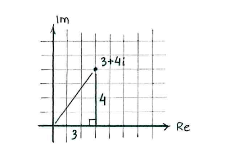Solution 3.2:4a
From Förberedande kurs i matematik 2
(Difference between revisions)
(Ny sida: {{NAVCONTENT_START}} <center> Bild:3_2_4a.gif </center> {{NAVCONTENT_STOP}}) |
m |
||
| (4 intermediate revisions not shown.) | |||
| Line 1: | Line 1: | ||
| - | {{ | + | The magnitude of the number <math>3+4i</math> is the number's distance to the origin in the complex number plane. |
| - | < | + | |
| - | {{ | + | If we treat the line from the origin to <math>3+4i</math> as the hypotenuse in a right-angled triangle which has its legs parallel with the real and imaginary axes, then the Pythagorean theorem gives that the magnitude is |
| + | |||
| + | {{Displayed math||<math>|3+4i| = \sqrt{3^2+4^2} = \sqrt{9+16} = \sqrt{25} = 5\,\textrm{.}</math>}} | ||
| + | |||
| + | [[Image:3_2_4_a.gif|center]] | ||
| + | |||
| + | |||
| + | Note: In general, the magnitude of a complex number <math>z=x+iy</math> is equal to | ||
| + | |||
| + | {{Displayed math||<math>|z| = |x+iy| = \sqrt{x^2+y^2}\,\textrm{.}</math>}} | ||
Current revision
The magnitude of the number \displaystyle 3+4i is the number's distance to the origin in the complex number plane.
If we treat the line from the origin to \displaystyle 3+4i as the hypotenuse in a right-angled triangle which has its legs parallel with the real and imaginary axes, then the Pythagorean theorem gives that the magnitude is
| \displaystyle |3+4i| = \sqrt{3^2+4^2} = \sqrt{9+16} = \sqrt{25} = 5\,\textrm{.} |
Note: In general, the magnitude of a complex number \displaystyle z=x+iy is equal to
| \displaystyle |z| = |x+iy| = \sqrt{x^2+y^2}\,\textrm{.} |

